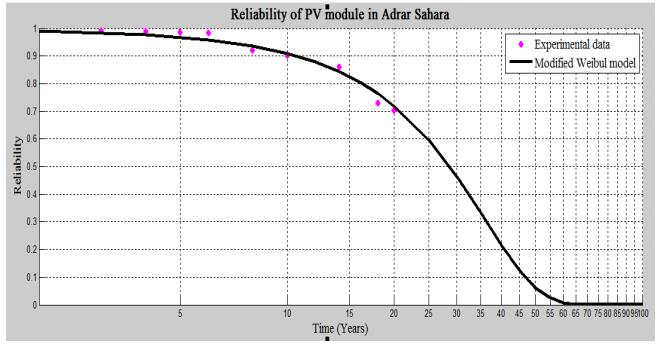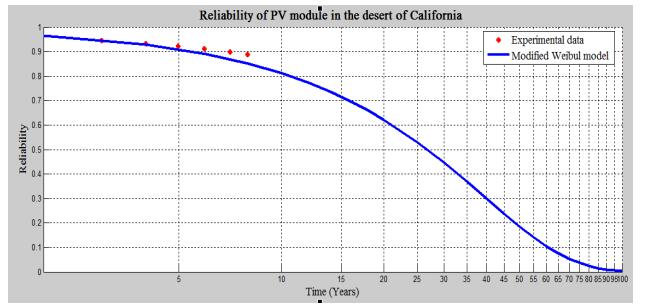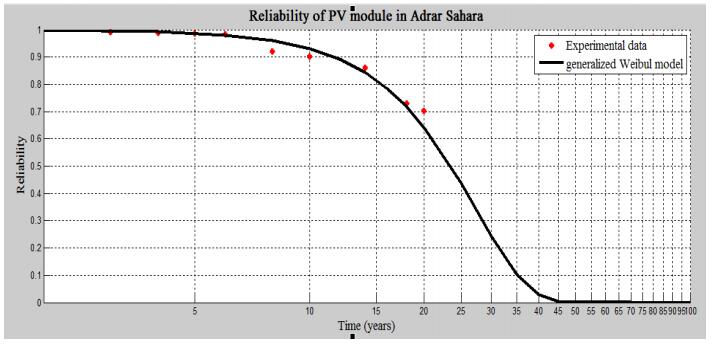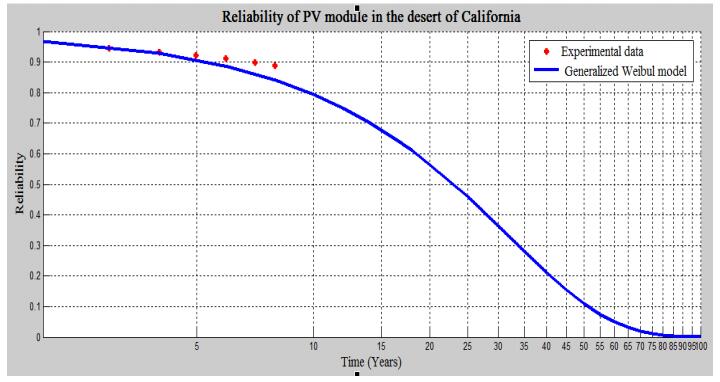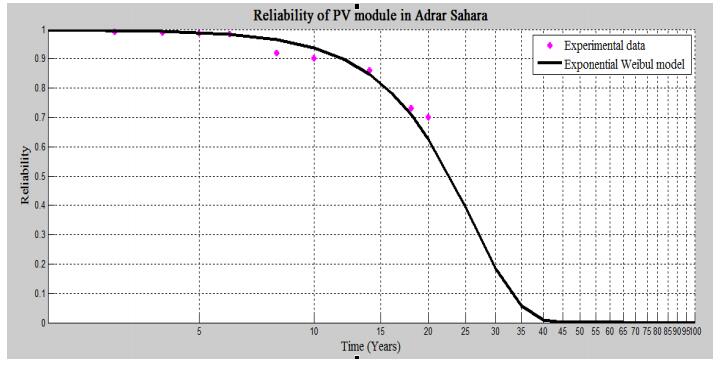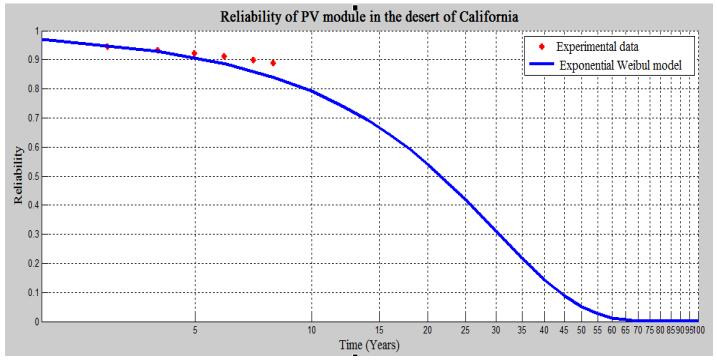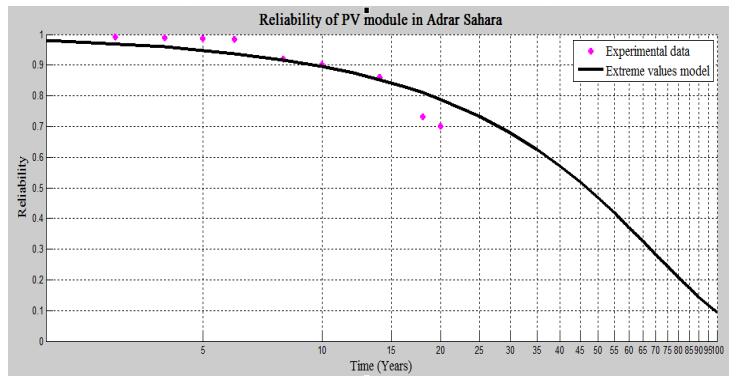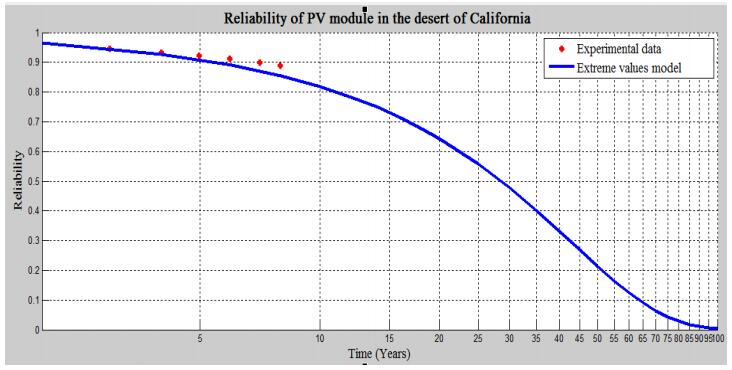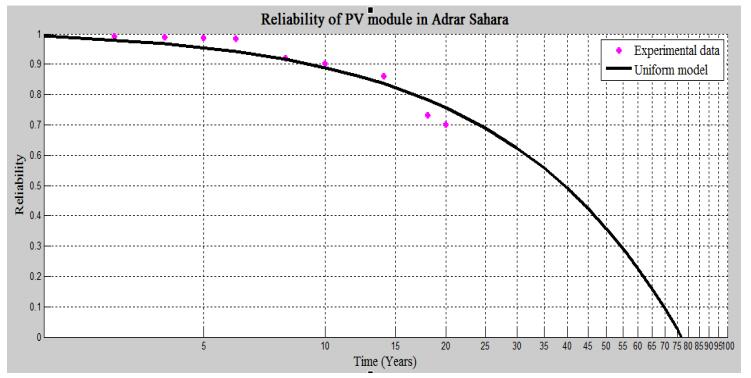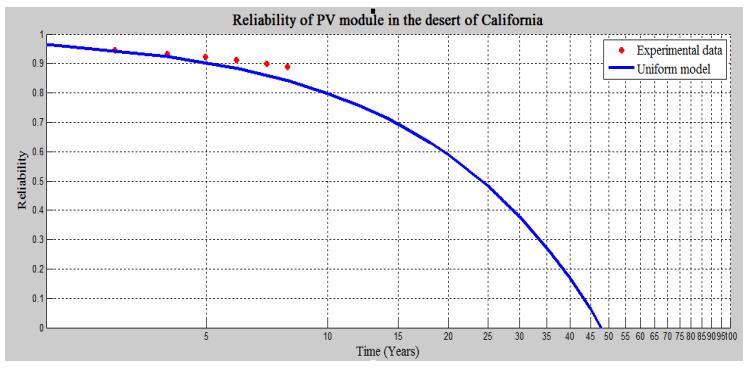The lifetime of a photovoltaic module operating in natural environment may never be known. It is useful to look for mathematical laws that are reliable in predicting the approximate warranty and performance times of these instruments before they fail. Literature is rich of many laws (parametric, semi-parametric or non-parametric) that have a high efficiency in all scientific branches. Parametric laws are used more than others in the branches of electronics. In this paper, we examined the validity of some reliability laws (15 models) to simulate the degradation of the maximum electrical power of crystalline silicon photovoltaic modules and to estimate their lifetimes when exposed to Saharan environments (especially the Sahara of Adrar in the South West of Algeria and the desert of California in the United States of America) where the climate is generally warm and dry during half a year. A genetic algorithm (a method of artificial intelligence) has been used here to calculate the parameters of each tested model. The modified Weibul model is the most adequate one compared to the other parametric models tested. In this study, the average lifespan of photovoltaic modules in the desert of California has been estimated to approximately 30 years (29 years for Adrar) for which the electrical energy supplied reaches 46% of its initial value. The prediction results must be taken into consideration for any construction study of a solar station in desert environments.
Abbreviations: (α, β, γ, η, θ, λ, μ, a, b): Model parameters; R (t): Reliability function; MTBF (τ): the average Lifetime; PV: Photovoltaic; a-Si: Amorphous silicon; pc-Si: Polycrystalline silicon; mc-Si: Single crystalline silicon
1.
Introduction
Many articles in literature have studied the degradation of photovoltaic modules when exposed to natural environments using accelerated tests to observe degradation in reality [1,2]. A study confirmed that after 20 years of continuous exposure a matrix of 70 polycrystalline silicon photovoltaic modules has undergone an average performance decay of 0.24% per year in a moderate subtropical climate environment [3,4]. Another study stated that after only one year of exposure in a tropical climate environment the electrical powers of two modules of type (a-Si) and (pc-Si) were degraded to 60% and 56% respectively of their initial values [5]. In addition to these results, another study has shown that some photovoltaic modules (mc-Si and pc-Si) had been degraded by 0.22% /year to 2.96% / year for the maximum power [6]. In the long run, the polycrystalline silicon modules have the best reliability with a degradation rate of 0.41% per year in a natural environment [7]. In a tropical environment (Ghana), the exposure of 14 polycrystalline silicon modules during a 19-year period recorded a degradation rate of 21% to 35% of nominal power [8]. The degradation is in the order of 1.2% per year for polycrystalline silicon modules and 0.8% per year for single crystalline silicon modules [9]. An important study that followed the degradation of 204 modules (123 mc-Si and 81 pc-Si) had revealed a degradation variance from 0 to 6% per year for exposure periods of 18 years to 24 years in a subtropical moderate environment [10]. In Saharan environment (southern Algeria for example) the degradation rate of polycrystalline silicon modules was very high ranging from 3.33% / year to 4.64% / year unlike mono-crystalline silicon modules which recorded a rate of 1.22% / year after 28 years of exposure [11,12]. Accelerated tests cannot evaluate totally the effect of natural environment on electrical and optical characteristics of a photovoltaic module [13]. But it is the only method to see the effect of single factor or limited number of climatic factors [13,14]. The return of experimental data within a period of operation in a natural environment allows to predict the lifetime and the degradation over the long term [15]. Our objective in this study is to search in the literature for an adequate model to simulate the reliability of photovoltaic modules (crystalline silicon) exposed in desert environments in order to probably estimate their degradation at any period of their operation. The method consists of using a genetic algorithm (artificial intelligence optimization method) to estimate the unknown parameters of the models and to check the competence of the simulation by comparing with feedbacks of experimental data.
2.
Research method
Two kinds of methods in the literature are used to predict the duration of good operation and the reliability of a photovoltaic module exposed in a natural environment, the first that uses the return of experiments, or the second that utilizes accelerated tests [16]. In this study, we use the feedback data that are practically measured in the desert of California and in the Algerian Sahara (Adrar region), extracted from references [16,17,18] to estimate the lifespan of photovoltaic modules (single crystalline silicon) in these environments. In order to calculate the parameters of models we will use a genetic algorithm. The iterative stochastic genetic algorithm uses an initial population to reach an optimal solution of any problem [19]. The initially chosen population has evolved from generation to generation where the most suitable individuals have a great chance of breeding. This mechanism of intelligence is realized by respecting the following steps [20,21]:
1. Creation of an initial population
2. Assessment of individuals in population
3. Selection of adapted individuals
4. Reproduction by crossing and mutation
5. Formation of a new generation
This process is circulated until an optimal solution is obtained. Practically, we represent these steps according to the flowchart below (Figure 1):
Originally, the reliability concerned the high technology systems (nuclear, aerospace...) to guarantee their operational safety. Today, all areas are interested in the study of reliability to make decisions on ratio Cost / gain and to control the failure sources [22,23]. Reliability of a system is a quantity characterizing the safety of operation or measuring the probability of operation of an appliance according to prescribed standards (definition presented in 1962 by the Academy of Sciences). Reliability (or survival function) is expressed by:
h(t): Instant failure rate (probability of seeing a failure in a short interval after instant t.
The average time of operation (lifetime) which is the Mean Time Before Failure (MTBF) is given by:
According to their instantaneous rates of failure, the parametric reliability models are classified in the literature as follows [24,25,26]:
1. Models of constant rate: Exponential model.
2. Models of monotone rate: Weibul model, gamma model, Gompertz-Makeham model, exponential Weibul model, Mix of exponential models.
3. Models of rates of a bathtub shape: Modified Weibul model, exponential power model, quadratic model, and uniform model.
4. Models of rate in bell form: Generalized Weibul model, normal model, log-normal model, log logistic model, extreme values model.
The characteristics of chosen models are presented in the table 1 below:
3.
Results and discussion
After filtering we present only the cases where the calculated average error is less than 2%. This choice is solely made to limit the size of the study. The other cases are not interesting as our goal is to visualize the most adequate model having the least error.
3.1. Simulation of reliability by modified Weibul model
Estimated parameters and simulated reliability graphs are shown below (Table 2, Figures 2 and 3):
After 20 years of operation in Adrar region we observe that the Weibul modified model predicts a 30% degradation of starting value of electrical power for this type of photovoltaic modules while the degradation is approximately of 38% in the desert of California.
3.2. Simulation of reliability by Generalized Weibul model
In the Table 3 and Figures (4, 5) we present the estimated parameters and the simulated reliability:
In this case the generalized Weibul model predicts a degradation of 35% in Adrar region after 20 years of operation while the degradation is approximately of 44% in the desert of California.
3.3. Simulation of reliability by exponential Weibul model
The Table 4 and the Figures 6, 7 show the estimated parameters and the simulated reliability of PV module:
By this model the degradation is about of 38% in Adrar region after 20 years of operation while the degradation is approximately of 46% in the desert of California.
3.4. Simulation of reliability by Extreme values model
Estimated parameters and simulated reliability graphs are shown below (Table 5, Figures 8 and 9):
By model of extreme values, the degradation is about of 22% in Adrar region after 20 years of operation while it is approximately of 37% in the desert of California.
3.5. Simulation of Reliability by Uniform model
In this case the estimated parameters and the simulated reliability are shown below (table 6, figure 10 and 11):
Finally, the uniform model predicts a degradation of 24% in Adrar region After 20 years of operation while it is approximately of 41% in the desert of California.
These results are summarized in the following Table 7.
The above results indicate that:
1. The experimental data used have guided us to predict the future of solar panels operating in desert environments. We therefore believe that more return data will give us confidence in models and methods.
2. The calculated mean error that present the average relative distance of the graph from the points of comparison is generally small (especially for the modified Weibul model). These reflect the skill of the optimization method used (the genetic algorithm).
3. Extrapolation of curves in longer durations allows informing on the reliability (outside of periods of real measurements).
4. The modified Weibul model is the most adequate of the models tested to simulate the reliability of photovoltaic modules (single crystalline silicon) and to estimate their lifetimes (MTBF) in the desert environments. It predicted a duration of nearly 30 years in the desert of California and of around 29 years for the Adrar area.
5. It should be noted that the degradation of electrical power of photovoltaic modules in Californian desert is significant compared to that of Adrar region in the first step (in the initial period of 30 years).
6. These obtained results are more or less comparable to those stated in references [11,12] (a degradation close to 1.53%
/year in this study).
4.
Conclusion
It has been confirmed in this article that the modified Weibul law is the most adequate model compared to other tested models to simulate the reliability function of photovoltaic modules and estimate their lifetime while operating in desert environments (California and Adrar). Using simulation findings, an average lifespan of about 30 years has been predicted for photovoltaic modules exposed in desert regions where the maximum power of the photovoltaic module is degraded to almost 46% of its initial value. The annual rate of degradation is in the order of 1.5% / year. This obtained result is more or less comparable to those presented in the literature. The prediction results must be taken into consideration for any study of construction of solar stations in the Saharan environments.
Acknowledgment
I thank my fellow researchers in Renewable Energy Research Unit in Saharan areas (URERMS) for all given help.
Conflict of interest
The authors declare there are no conflicts of interest in this paper.
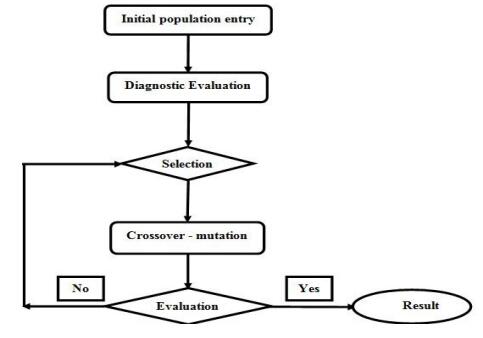









 DownLoad:
DownLoad:
